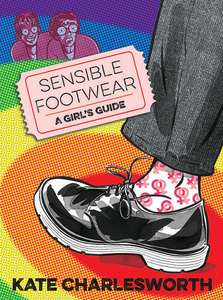Sensible Footwear: A Girl’s Guide is Kate Charlesworth’s combination cook’s tour of 20th queer history in the UK and memoir of being a lesbian cartoonist born in 1950s Yorkshire. It covers attempts at local organising, queer publishing houses, and her experiences with trying to find a queer community, along with the shift in attitudes to queerness (and the massive amounts of work done to shift those attitudes) in culture and politics.
The cast is huge and frequently bewildering to me; Kate Charlesworth knew A LOT of organisers and creators, and I struggled to distinguish everyone and remember who they were and what role they had in her life. People are mentioned to have died, and I was left looking at the page blankly trying to work out whether it was anyone that had been mentioned before this! Despite that, I really did appreciate how well she managed to make it clear that she and her friends were aging, while keeping them recognisable. It helps that her drawings seem to be fairly accurate, based on the photographs and her depiction of celebrities, and I adored her ability to catch tiny, realistic expressions as well as the cartoonish exaggerations. And her depictions of the places she’s lived are excellent; her depiction of Manchester’s gay village was instantly recognisable! I also liked her coloured washes, and the way that they give immediate context for what time period you’re reading about.
The memoir parts are mostly done in comic form, while the history side of things is laid out like a scrapbook, full of sketches, photographs, activist badges, scribbled notes, and Gilbert & Sullivan parodies. I did have some problems with the panelling of the comics sections (there are sections where it’s unclear whether the page carries on across a double-page spread or not, which is a shame because those pages are often the best looking ones), but I really liked the scrapbook style. Some of it was chaotic, but for the most part it was full of visual interest and gave a lot of context to the movements and activism of the time. Her overviews were fascinating, especially of how there were wide gaps in opinions within the same activist groups, let alone the same queer communities. Plus, she does specifically acknowledge that bisexuality, trans people, and shifting cultural norms exist, which is such a change from the latest queer books I’ve read. It feels a little bit like discovering Dykes To Watch Out For as someone who wasn’t even born when it started being released; both of them are a steady, shifting acknowledgement of the way that our cultural approaches to queerness and gender are changing over time, both represent activism and politics as an integral parts of people’s identities, and both capture the historical attitudes of queer women, just in very different ways.
All that said, the ending itself didn’t hold up for me; I liked the idea of the aurora queerialis as an acknowledgement of how much things have changed and how many different ways there are to be queer, apart from the paths that she and her friends took, but I found its textual acknowledgement to be clunky. I’m also fundamentally suspicious of any narrative that posits that someone who was actively homophobic (in this case, Kate Charlesworth’s mother) was that way because they were queer themselves and in denial, but this is a memoir, and if that is how Kate Charlesworth chooses to remember and depict her mother, more power to her. I just found it tonally jarring, and a really odd note to end the book on.
What hits me hardest about Sensible Footwear is how much of it I didn’t know. I was at school during Section 28, which was a law the British government passed that banned schools from “promoting homosexuality”, and I didn’t even know about it until last year. Seeing it shown on page, seeing how angry people were about it, feels like validation of how angry I am knowing that “You are not broken or alone” was a message deemed too dangerous for me and other children. The recurring themes in queer histories is “We’re here, we’ve always been here,” and Sensible Footwear felt like Kate Charlesworth was throwing a guide rope back to give people like me – people who weren’t alive for most of this, people who don’t know where to look to find queer history – a link to the community’s past, and that is immensely valuable all on its own.
… Although let’s face it, as a queer lass from Lancashire, we all knew that I was going to give it the highest of recommendations from the moment it taught me that in 1960s Yorkshire, “bats for Lancashire” was a euphemism for being queer!
Caution warnings: Homophobia, the AIDs Crisis, sexual harassment, forced outing, references to historical treatment of queer people including aversion therapy and chemical castration.
Susan is a library assistant who uses her insider access to keep her shelves and to-read list permanently overflowing. She can usually be found as a contributing editor for Hugo-winning media blog Lady Business, or a reviewing for SFF Reviews and Smart Bitches Trashy Books. She brings the tweets and shouting on twitter.

